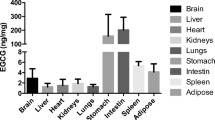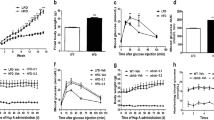Abstract
Alzheimer’s disease (AD) fundamentally represents a metabolic disease associated with brain insulin resistance. TNF-α/c-Jun N-terminal kinase (JNK) signaling plays a central role in serine phosphorylation of insulin receptor substrate-1 (IRS-1). (−)-Epigallocatechin-3-gallate (EGCG), a potent antioxidant, has been verified to attenuate peripheral insulin resistance by reducing IRS-1 signaling blockage. This study aimed to investigate the effects and possible mechanisms of EGCG on central IRS-1 signaling in vivo. APP/PS1 mice were treated with EGCG, and spatial memory was assessed by the Morris water maze test. Levels of soluble and insoluble Aβ42 in the hippocampus were determined by ELISA. The activation of NF-α/JNK and IRS signaling was detected by immunohistochemistry and Western blot analysis. Our results showed that EGCG ameliorated the impaired learning and memory in APP/PS1 mice. Notably, we found a significant reduction of IRS-1pS636 level accompanied with decreased Aβ42 levels in the hippocampus of 13-month-old female APP/PS1 mice after treatment with EGCG (2 or 6 mg/kg/day) for 4 weeks. Furthermore, EGCG treatment inhibited TNF-α/JNK signaling and increased the phosphorylation of Akt and glycogen synthase kinase-3β in the hippocampus of APP/PS1 mice. In conclusion, our study provides evidence that long-term consumption of EGCG may alleviate AD-related cognitive deficits by effectively attenuating central insulin resistance.






Similar content being viewed by others
References
Chiu SL, Chen CM, Cline HT (2008) Insulin receptor signaling regulates synapse number, dendritic plasticity, and circuit function in vivo. Neuron 58:708–719
Bosco D, Plastino M, Cristiano D, Colica C, Ermio C, De Bartolo M, Mungari P, Fonte G, Consoli D, Consoli A, Fava A (2012) Dementia is associated with insulin resistance in patients with Parkinson’s disease. J Neurol Sci 315:39–43
de la Monte SM (2012) Brain insulin resistance and deficiency as therapeutic targets in Alzheimer’s disease. Curr Alzheimer Res 9:35–66
Hirosumi J, Tuncman G, Chang L et al (2002) A central role for JNK in obesity and insulin resistance. Nature 420:333–336
Bomfim TR, Forny-Germano L, Sathler LB et al (2012) An anti-diabetes agent protects the mouse brain from defective insulin signaling caused by Alzheimer’s disease-associated Aβ oligomers. J Clin Invest 122:1339–1353
Yamato M, Shiba T, Ide T, Seri N, Kudo W, Ando M, Yamada K, Kinugawa S, Tsutsui H (2012) High-fat diet-induced obesity and insulin resistance were ameliorated via enhanced fecal bile acid excretion in tumor necrosis factor-alpha receptor knockout mice. Mol Cell Biochem 359:161–167
Balasubramanyam M, Aravind S, Gokulakrishnan K, Prabu P, Sathishkumar C, Ranjani H, Mohan V (2011) Impaired miR-146a expression links subclinical inflammation and insulin resistance in Type 2 diabetes. Mol Cell Biochem 351:197–205
Gual P, Le Marchand-Brustel Y, Tanti JF (2005) Positive and negative regulation of insulin signaling through IRS-1 phosphorylation. Biochimie 87:99–109
Li Y, Zhao S, Zhang W et al (2011) Epigallocatechin-3-O-gallate (EGCG) attenuates FFAs-induced peripheral insulin resistance through AMPK pathway and insulin signaling pathway in vivo. Diabetes Res Clin Pract 93:205–214
Deng YT, Chang TW, Lee MS, Lin JK (2012) Suppression of free fatty acid-induced insulin resistance by phytopolyphenols in C2C12 mouse skeletal muscle cells. J Agric Food Chem 60:1059–1066
Kim B, Feldman EL (2012) Insulin resistance in the nervous system. Trends Endocrinol Metab 23:133–141
Engel T, Lucas JJ, Hernández F, Avila J (2007) A mouse model to study tau pathology related with tau phosphorylation and assembly. J Neurol Sci 257:250–254
Koyama Y, Abe K, Sano Y et al (2004) Effects of green tea on gene expression of hepatic gluconeogenic enzymes in vivo. Planta Med 70:1100–1102
Rezai-Zadeh K, Shytle D, Sun N et al (2005) Green tea epigallocatechin-3-gallate (EGCG) modulates amyloid precursor protein cleavage and reduces cerebral amyloidosis in Alzheimer transgenic mice. J Neurosci 25:8807–8814
Gokulakrisnan A, Jayachandran Dare B, Thirunavukkarasu C (2011) Attenuation of the cardiac inflammatory changes and lipid anomalies by (−)-epigallocatechin-gallate in cigarette smoke-exposed rats. Mol Cell Biochem 354:1–10
Shankar S, Marsh L, Srivastava RK (2013) EGCG inhibits growth of human pancreatic tumors orthotopically implanted in Balb C nude mice through modulation of FKHRL1/FOXO3a and neuropilin. Mol Cell Biochem 372:83–94
Rezai-Zadeh K, Arendash GW, Hou H et al (2008) Green tea epigallocatechin-3-gallate (EGCG) reduces beta-amyloid mediated cognitive impairment and modulates tau pathology in Alzheimer transgenic mice. Brain Res 1214:177–187
Lee JW, Lee YK, Ban JO et al (2009) Green tea (−)-epigallocatechin-3-gallate inhibits beta-amyloid-induced cognitive dysfunction through modification of secretase activity via inhibition of ERK and NF-kappaB pathways in mice. J Nutr 139:1987–1993
Haass C, Selkoe DJ (2007) Soluble protein oligomers in neurodegeneration: lessons from the Alzheimer’s amyloid beta-peptide. Nat Rev Mol Cell Biol 8:101–112
Talbot K, Wang HY, Kazi H et al (2012) Demonstrated brain insulin resistance in Alzheimer’s disease patients is associated with IGF-1 resistance, IRS-1 dysregulation, and cognitive decline. J Clin Invest 122:1316–1338
Acknowledgments
This study was supported by Natural Science Foundation of China (Grant No. 81172371); Social Development Research Projects of Science and Technology Department in Liaoning Province (Grant No. 2012225019); Science and Technology Research Funds of Liaoning Medical University for Youth (Grant No. Y2012z001); First Affiliated Hospital Science and Technology Research Funds of Liaoning Medical University (Grant No. FYK201205 and FY2012-01).
Conflict of interest
The authors declare that they have no competing interests.
Author information
Authors and Affiliations
Corresponding author
Rights and permissions
About this article
Cite this article
Jia, N., Han, K., Kong, JJ. et al. (−)-Epigallocatechin-3-gallate alleviates spatial memory impairment in APP/PS1 mice by restoring IRS-1 signaling defects in the hippocampus. Mol Cell Biochem 380, 211–218 (2013). https://doi.org/10.1007/s11010-013-1675-x
Received:
Accepted:
Published:
Issue Date:
DOI: https://doi.org/10.1007/s11010-013-1675-x




